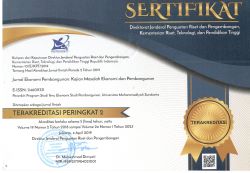DAMPAK KETIDAKSTABILAN NILAI TUKAR RUPIAH TERHADAP PERMINTAAN UANG M2 DI INDONESIA
Etty Puji Lestari(1*)(1) Fakultas Ekonomi Universitas Terbuka, Jakarta
(*) Corresponding Author
Abstract
Keywords
Full Text:
PDFReferences
Baba, Y., D.F. Hendry, dan R.M. Starr, 1992, The Demand for M1 in the USA, 1960-1988. Review Economic Studies. 59. 25-61.
Badan Pusat Statistik. 2003. Indikator Eko-nomi. www.bps.go.id
Bank Indonesia. 1997. Laporan Tahunan Bank Indonesia. www.bi.go.id
Bank Indonesia. 1999. Laporan Tahunan Bank Indonesia. www.bi.go.id
Dickey, D.P., dan W.A., Fuller. 1981. Like-lihood Ratio Statistics for Autoregres-sive Time Series with a Unit Root.
Econometrica (Journal). 49. 1057 – 1072.
Domowitz, I, dan Elbadawi. 1987. An Error Correction Approach to Money De-mand: The Case of Sudan. Journal of Development Economics. 25.257-275.
Dutton, D.S dan Gramm, W.P. 1973. Trans-action Cost, The Wage Rate dan The Demand for Money. American Eco-nomic Review. No. 63, 652-665
Greene, W.H. 2000. Econometric Analysis. Fourth Edition. Prentice Hall
Gujarati, D., 2003. Basic Econometric. Fifth Edition. New Jersey: McGraw-Hill, Inc.
Handoyo, R.D. (2002). Permintaan Uang M1 Asean-4, Singapura, Thailand, Malaysia dan Indonesia, 1980.1–1999.4, Estimasi Data Non Stasioner. Tesis. Universitas Gadjah Mada, tidak dipublikasikan.
Hendry, D., dan Ericson N. 1991. Econome-tric Analysis U.K. Money Demand in Monetary Trends in the United States and the United Kingdom. The American Economic Review. 81. 1-80.
Insukindro. 1991. Regresi Linier Lancung dalam Analisis Ekonomi: Suatu tinjauan dengan Studi Kasus Indonesia. Jurnal Ekonomi dan Bisnis Indonesia. 18-23.
Insukindro. 1998. Sindrum R2 dalam Analisis Regresi Linier Runtun Waktu. Jurnal Ekonomi dan Bisnis Indonesia. 7, 1-17
Morimune, K dan Zhao,G.Q. 1997. Non Sta-tionary Estimation of the Japanese Money Demand Function. Journal of Economic Research. 2.1-28
Wickens, M.R., dan Brusch T.S.1988. The Dynamics Specification, The Long-run and Estimation of Transformed Regres-sion Models. Economic Journal. 98. (Suplemen). 189-205.
Article Metrics
Abstract view(s): 1803 time(s)PDF: 1248 time(s)
Refbacks
- There are currently no refbacks.















